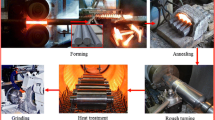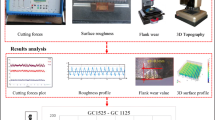Abstract
A comparative study is undertaken in terms of the surface roughness criterion (Ra), the tangential cutting force (Fz), the cutting power (Pc), and the material removal rate (MRR) in turning of EN-GJL-250 cast iron using both coated and uncoated silicon nitride ceramics (Si3N4). The experimental procedure is carried out according to L27 Taguchi design process, and the analysis of variance ANOVA approach used to identify the cutting parameters that most influence the responses gathered. The artificial neural network approach (ANN) and the response surface methodology (RSM) were adopted to developing the mathematical prediction models applied in the optimization procedure that used genetic algorithm (GA). The predictive capabilities of the ANN and RSM models were further compared in terms of their mean absolute deviation (MAD), mean absolute error in percent (MAPE), mean square error (RMSE), and coefficient of determination (R2). It has been found that the ANN method provides more precise results compared to those of the RSM approach. Moreover, the coated ceramic tool has been found to lead to a better surface quality and a minimum cutting force compared to those obtained by uncoated ceramic. The wear tests undertaken show that, when the flank wear reaches the admissible value of [Vb] = 0.3 mm, the ratios (tool life CC1690/tool life CC6090), (RaCC1690/RaCC6090), and (FzCC1690/FzCC6090) are found to equal 0.88, 1.4, and 0.94, respectively.
Similar content being viewed by others
References
Özel T, Karpat Y (2005) Predictive modeling of surface roughness and tool wear in hard turning using regression and neural networks. Int J Mach Tools Manuf 45(4–5):467–479
Tapoglou N, Lopez MIA, Cook I, Taylor CM (2017) Investigation of the influence of CO2 cryogenic coolant application on tool wear. Procedia CIRP 63:745–749
Danish M, Ginta TL, Habib K, Abdul Rani AM, Saha BB (2018) Effect of cryogenic cooling on the heat transfer during turning of AZ31C magnesium alloy. Heat Transfer Eng 1–10. https://doi.org/10.1080/01457632.2018.1450345
Bensouilah H, Aouici H, Meddour I, Yallese MA, Mabrouki T, Girardin F (2016) Performance of coated and uncoated mixed ceramic tools in hard turning process. Measurement 82:1–18
Nouioua M, Yallese MA, Khettabi R, Belhadi S, Mabrouki T (2017) Comparative assessment of cooling conditions, including MQL technology on machining factors in an environmentally friendly approach. Int J Adv Manuf Technol 91(9–12):3079–3094
Khellaf A, Aouici H, Smaiah S, Boutabba S, Yallese MA, Elbah M (2017) Comparative assessment of two ceramic cutting tools on surface roughness in hard turning of AISI H11 steel: including 2D and 3D surface topography. Int J Adv Manuf Technol 89(1–4):333–354
Ho WH, Tsai JT, Lin BT, Chou JH (2009) Adaptive network-based fuzzy inference system for prediction of surface roughness in end milling process using hybrid Taguchi-genetic learning algorithm. Expert Syst Appl 36(2):3216–3222
Kumanan S, Jesuthanam CP, Kumar RA (2008) Application of multiple regression and adaptive neuro fuzzy inference system for the prediction of surface roughness. Int J Adv Manuf Technol 35(7–8):778–788
Maher I, Eltaib MEH, Sarhan AA, El-Zahry RM (2014) Investigation of the effect of machining parameters on the surface quality of machined brass (60/40) in CNC end milling—ANFIS modeling. Int J Adv Manuf Technol 74(1–4):531–537
Maran JP, Sivakumar V, Thirugnanasambandham K, Sridhar R (2013) Artificial neural network and response surface methodology modeling in mass transfer parameters predictions during osmotic dehydration of Carica papaya L. Alex Eng J 52(3):507–516
Nouioua M, Yallese MA, Khettabi R, Belhadi S, Bouhalais ML, Girardin F (2017) Investigation of the performance of the MQL, dry, and wet turning by response surface methodology (RSM) and artificial neural network (ANN). Int J Adv Manuf Technol 93(5–8):2485–2504
Hossain MSJ, Ahmad N (2014) Surface roughness prediction modelling for commercial dies using ANFIS, ANN and RSM. Int J Ind Syst Eng 16(2):156–183
Kamruzzaman M, Rahman SS, Ashraf MZI, Dhar NR (2017) Modeling of chip–tool interface temperature using response surface methodology and artificial neural network in HPC-assisted turning and tool life investigation. Int J Adv Manuf Technol 90(5–8):1547–1568
Yücel E, Günay M (2013) Modelling and optimization of the cutting conditions in hard turning of high-alloy white cast iron (Ni-hard). Proc Inst Mech Eng C J Mech Eng Sci 227(10):2280–2290
Fetecau C, Stan F (2012) Study of cutting force and surface roughness in the turning of polytetrafluoroethylene composites with a polycrystalline diamond tool. Measurement 45(6):1367–1379
Zhong ZW, Khoo LP, Han ST (2006) Prediction of surface roughness of turned surfaces using neural networks. Int J Adv Manuf Technol 28(7–8):688–693
Mia M, Dhar NR (2016) Response surface and neural network based predictive models of cutting temperature in hard turning. J Adv Res 7(6):1035–1044
Chabbi A, Yallese MA, Nouioua M, Meddour I, Mabrouki T, Girardin F (2017) Modeling and optimization of turning process parameters during the cutting of polymer (POM C) based on RSM, ANN, and DF methods. Int J Adv Manuf Technol 91(5–8):2267–2290
Tebassi H, Yallese MA, Meddour I, Girardin F, Mabrouki T (2017) On the modeling of surface roughness and cutting force when turning of Inconel 718 using artificial neural network and response surface methodology: accuracy and benefit. Period Polytech Mech Engrg 61(1):1–11
Danish M, Ginta TL, Habib K, Carou D, Rani AMA, Saha BB (2017) Thermal analysis during turning of AZ31 magnesium alloy under dry and cryogenic conditions. Int J Adv Manuf Technol 91(5–8):2855–2868
Yousuff CM, Danish M, Ho ETW, Kamal Basha IH, Hamid NHB (2017) Study on the optimum cutting parameters of an aluminum mold for effective bonding strength of a PDMS microfluidic device. Micromachines 8(8):258
Kumar R, Chauhan S (2015) Study on surface roughness measurement for turning of Al 7075/10/SiCp and Al 7075 hybrid composites by using response surface methodology (RSM) and artificial neural networking (ANN). Measurement 65:166–180
D’Addona DM, Raykar SJ (2016) Analysis of surface roughness in hard turning using wiper insert geometry. Procedia CIRP 41:841–846
Lin WS, Lee BY, Wu CL (2001) Modeling the surface roughness and cutting force for turning. J Mater Process Technol 108(3):286–293
Yallese MA, Boulanouar L, Chaoui K (2004) Usinage de l’acier 100Cr6 trempé par un outil en nitrure de bore cubique. Mechanics Industry 5(4):355–368
Bouchelaghem H, Yallese MA, Amirat A, Belhadi S (2007) Wear behaviour of CBN tool when turning hardened AISI D3 steel. Mechanics 65(3):57–65
Yallese MA, Chaoui K, Zeghib N, Boulanouar L, Rigal JF (2009) Hard machining of hardened bearing steel using cubic boron nitride tool. J Mater Process Technol 209(2):1092–1104
Bouzid L, Yallese MA, Chaoui K, Mabrouki T, Boulanouar L (2015) Mathematical modeling for turning on AISI 420 stainless steel using surface response methodology. Proc Inst Mech Eng B J Eng Manuf 229(1):45–61
Elbah M, Yallese MA, Aouici H, Mabrouki T, Rigal JF (2013) Comparative assessment of wiper and conventional ceramic tools on surface roughness in hard turning AISI 4140 steel. Measurement 46(9):3041–3056
Singh KP, Basant A, Malik A, Jain G (2009) Artificial neural network modeling of the river water quality—a case study. Ecol Model 220(6):888–895
Feng CX (2001) An experimental study of the impact of turning parameters on surface roughness. In Proceedings of the industrial engineering research conference (Vol. 2036)
Saravanan RSRS, Sankar RS, Asokan P, Vijayakumar K, Prabhaharan G (2005) Optimization of cutting conditions during continuous finished profile machining using non-traditional techniques. Int J Adv Manuf Technol 26(1–2):30–40
Reddy NSK, Rao PV (2005) Selection of optimum tool geometry and cutting conditions using a surface roughness prediction model for end milling. Int J Adv Manuf Technol 26(11–12):1202–1210
Yallese MA, Rigal JF, Chaoui K, Boulanouar L (2005) The effects of cutting conditions on mixed ceramic and cubic boron nitride tool wear and on surface roughness during machining of X200Cr12 steel (60 HRC). Proc Inst Mech Eng B J Eng Manuf 219(1):35–55
Özel T, Karpat Y, Figueira L, Davim JP (2007) Modelling of surface finish and tool flank wear in turning of AISI D2 steel with ceramic wiper inserts. J Mater Process Technol 189(1–3):192–198
Özel T, Nadgir A (2002) Prediction of flank wear by using back propagation neural network modeling when cutting hardened H-13 steel with chamfered and honed CBN tools. Int J Mach Tools Manuf 42(2):287–297
Bouchelaghem H, Yallese MA, Mabrouki T, Amirat A, Rigal JF (2010) Experimental investigation and performance analyses of CBN insert in hard turning of cold work tool steel (D3). Mach Sci Technol 14(4):471–501
Aouici H, Yallese MA, Fnides B, Chaoui K, Mabrouki T (2011) Modeling and optimization of hard turning of X38CrMoV5-1 steel with CBN tool: machining parameters effects on flank wear and surface roughness. J Mech Sci Technol 25(11):2843–2851
Sahoo AK, Sahoo B (2012) Experimental investigations on machinability aspects in finish hard turning of AISI 4340 steel using uncoated and multilayer coated carbide inserts. Measurement 45(8):2153–2165
Meddour I, Yallese MA, Khattabi R, Elbah M, Boulanouar L (2015) Investigation and modeling of cutting forces and surface roughness when hard turning of AISI 52100 steel with mixed ceramic tool: cutting conditions optimization. Int J Adv Manuf Technol 77(5–8):1387–1399
Swain N, Venkatesh V, Kumar P, Srinivas G, Ravishankar S, Barshilia HC (2017) An experimental investigation on the machining characteristics of Nimonic 75 using uncoated and TiAlN coated tungsten carbide micro-end mills. CIRP J Manuf Sci Technol 16:34–42
Sharif S, Rahim EA (2007) Performance of coated-and uncoated-carbide tools when drilling titanium alloy—Ti–6Al4V. J Mater Process Technol 185(1–3):72–76
Author information
Authors and Affiliations
Corresponding author
Additional information
Highlights
ANN is a very robust method for prediction the cutting parameters.
RSM is a very good method for classification and identification.
ANN and RSM methods as they seem to be complementary.
GA optimization can compromise between various responses.
The ratio of the full tests RaCC1690/RaCC6090 ≈ 0.88.
The ratio of the tool life C1690/tool life C6090 ≈ 1.4.
The 3D topographies is an important investigation tool for surface roughness.
Rights and permissions
About this article
Cite this article
Laouissi, A., Yallese, M.A., Belbah, A. et al. Investigation, modeling, and optimization of cutting parameters in turning of gray cast iron using coated and uncoated silicon nitride ceramic tools. Based on ANN, RSM, and GA optimization. Int J Adv Manuf Technol 101, 523–548 (2019). https://doi.org/10.1007/s00170-018-2931-8
Received:
Accepted:
Published:
Issue Date:
DOI: https://doi.org/10.1007/s00170-018-2931-8




